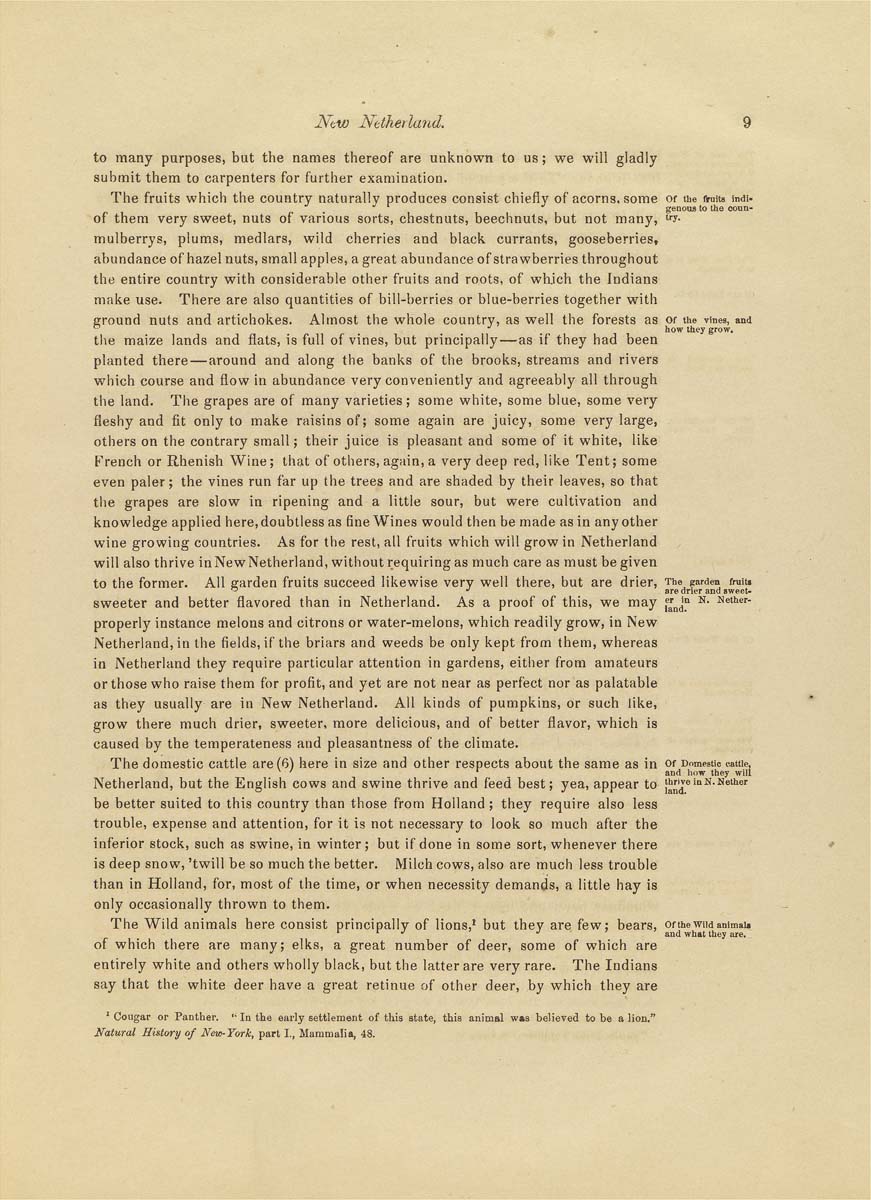Ntw NttJieiiand. 9
to many purposes, but the names thereof are unknown to us; we will gladly
submit them to carpenters for further examination.
The fruits which the country naturally produces consist chiefly of acorns, some of the rmits indi.
genous to the coun-
of them very sweet, nuts of various sorts, chestnuts, beechnuts, but not many, ^^^y.
mulberrys, plums, medlars, wild cherries and black currants, gooseberries,
abundance of hazel nuts, small apples, a great abundance of strawberries throughout
the entire country with considerable other fruits and roots, of which the Indians
make use. There are also quantities of bill-berries or blue-berries together with
ground nuts and artichokes. Almost the whole country, as well the forests as of the vines, and
" how they grow.
the maize lands and flats, is full of vines, but principally — as if they had been
planted there — around and along the banks of the brooks, streams and rivers
which course and flow in abundance very conveniently and agreeably all through
the land. The grapes are of many varieties; some white, some blue, some very
fleshy and fit only to make raisins of; some again are juicy, some very large,
others on the contrary small; their juice is pleasant and some of it white, like
French or Rhenish Wine; that of others, again, a very deep red, like Tent; some
even paler; the vines run far up the trees and are shaded by their leaves, so that
the grapes are slow in ripening and a little sour, but were cultivation and
knowledge applied here, doubtless as fine Wines would then be made as in any other
wine growing countries. As for the rest, all fruits which will grow in Netherland
will also thrive in New Netherland, without requiring as much care as must be given
to the former. All garden fruits succeed likewise very well there, but are drier, The jrarden fruit*
*-■ •' are drier and sweet-
sweeter and better flavored than in Netherland. As a proof of this, we may ^^^ ^- Aether-
properly instance melons and citrons or water-melons, which readily grow, in New
Netherland, in the fields, if the briars and weeds be only kept from them, whereas
in Netherland they require particular attention in gardens, either from amateurs
or those who raise them for profit, and yet are not near as perfect nor as palatable
as they usually are in New Netherland. All kinds of pumpkins, or such like,
grow there much drier, sweeter, more delicious, and of better flavor, which is
caused by the temperateness and pleasantness of the climate.
The domestic cattle are (6) here in size and other respects about the same as in of Domestic cattle,
' _ and how they will
Netherland, but the English cows and swine thrive and feed best; yea, appear to thrive in n. Nether
be better suited to this country than those from Holland ; they require also less
trouble, expense and attention, for it is not necessary to look so much after the
inferior stock, such as swine, in winter; but if done in some sort, whenever there
is deep snow, 'twill be so much the better. Milch cows, also are much less trouble
than in Holland, for, most of the time, or when necessity demands, a little hay is
only occasionally thrown to them.
The Wild animals here consist principally of lions,* but they are few; bears, ofthewiidanimal*
f^ ^ J J and what they are.
of which there are many; elks, a great number of deer, some of which are
entirely white and others wholly black, but the latter are very rare. The Indians
say that the white deer have a great retinue of other deer, by which they are
' Cougar or Panther. •• In the early settlement of this state, this animal w»s believed to be a lion."
Natural History of New-York, part I., Mammalia, 48.
|








